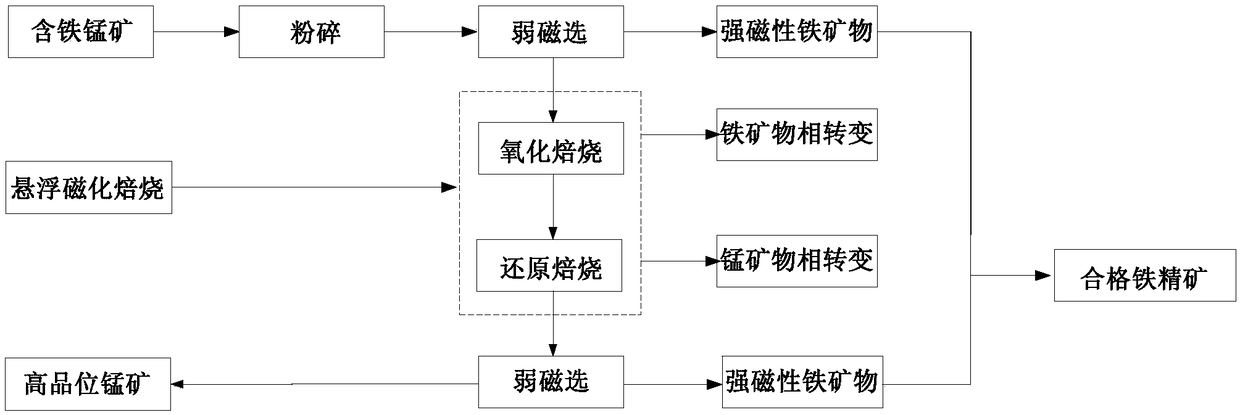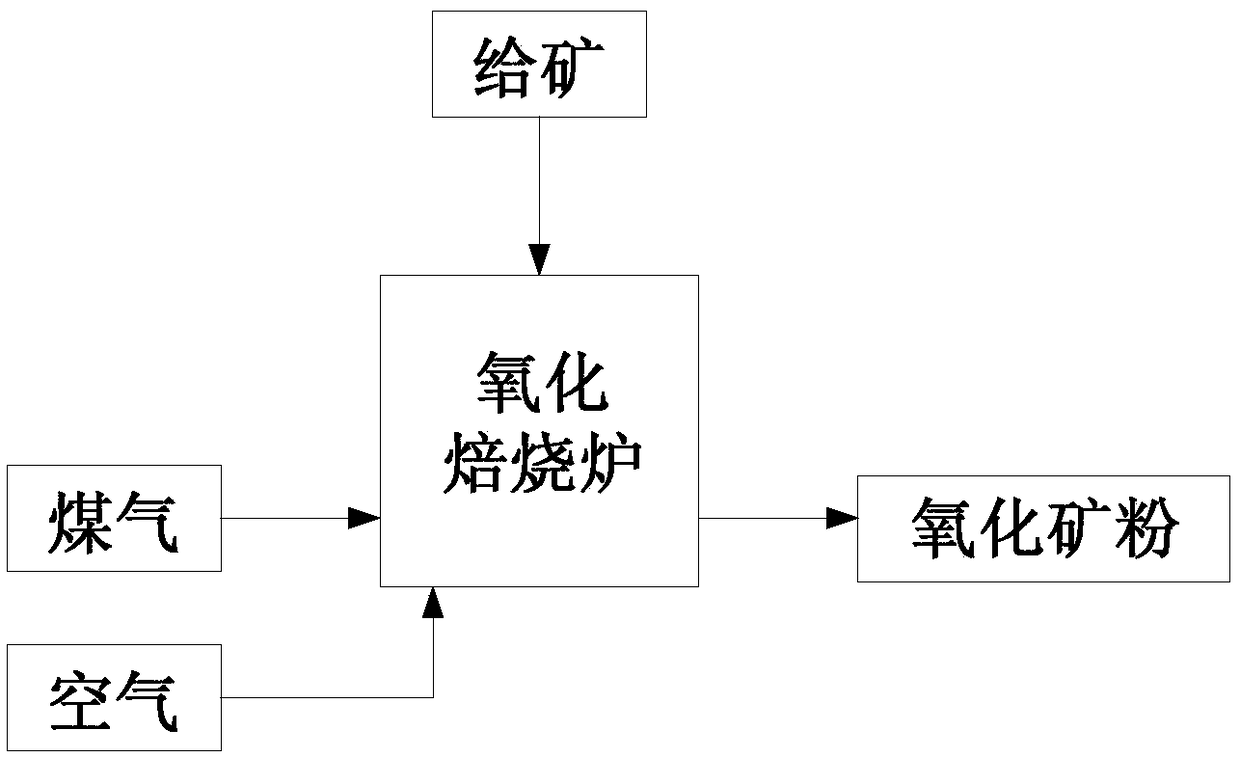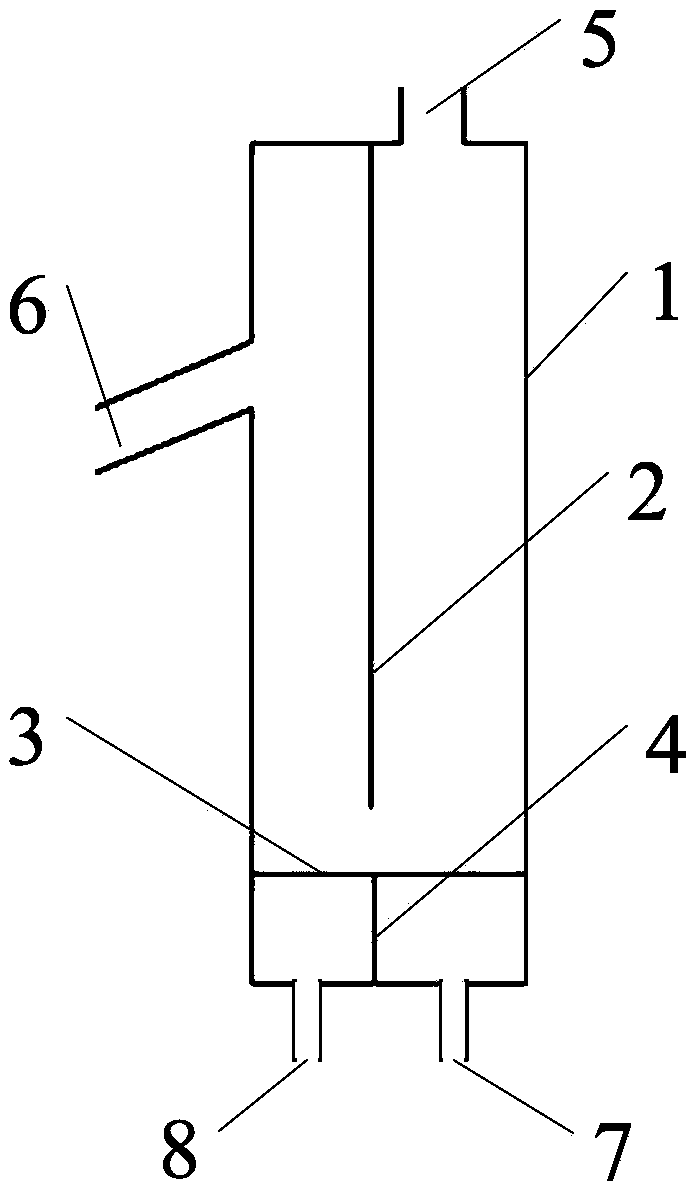A kind of suspension roasting ferromanganese separation treatment method of ferromanganese ore
A separation treatment and suspension roasting technology, applied in the field of mineral processing, can solve the problems of poor reduction effect, complicated process and process of mixing bituminous coal, and difficulty in separating iron and manganese from reduction products.
- Summary
- Abstract
- Description
- Claims
- Application Information
AI Technical Summary
Problems solved by technology
Method used
Image
Examples
Embodiment 1
[0028] Process such as figure 1 shown;
[0029] Crush the ferromanganese ore to a particle size of 2-20mm, and then grind the ore to a particle size of -0.074mm, accounting for 50% of the total weight, to make fine ore;
[0030] The powder ore is subjected to a stage of weak magnetic separation, with a magnetic field strength of 2000Oe, to obtain a stage of weak magnetic separation concentrate and a stage of weak magnetic separation tailings;
[0031] Put a section of weak magnetic separation tailings in the roasting furnace, feed gas and air to keep a section of weak magnetic separation tailings in a suspended state, and oxidize and roast a section of weak magnetic separation tailings at a roasting temperature of 800°C for a roasting time of 20 minutes. Volatilize water and other volatile components, and oxidize iron to Fe 2 o 3 , to obtain oxidized powder ore; the flow rate of gas and air is 13m per ton of weak magnetic separation tailings 3 / h; oxidation roasting proce...
Embodiment 2
[0037] Method is with embodiment 1, and difference is:
[0038] (1) Crush the iron-manganese ore to a particle size of 2~20mm, and then grind the ore to a particle size of -0.074mm, which accounts for 60% of the total weight, and make fine ore;
[0039] (2) The magnetic field strength of a section of weak magnetic separation is 1800Oe;
[0040](3) Oxidation roasting temperature 900°C, time 12min, to volatilize water and other volatiles, and oxidize iron to Fe 2 o 3 , to obtain oxidized powder ore; the flow rate of gas and air is 19m per ton of weak magnetic separation tailings 3 / h;
[0041] (4) The reduction roasting temperature is 600°C, the time is 8min, and the reducing gas is H 2 , the flow rate of reducing gas is H 2 The total amount is 10m 3 / h; the ratio of nitrogen and reducing gas is 3:1;
[0042] (5) The magnetic field strength of the second-stage weak magnetic separation is 1800Oe;
[0043] (6) The iron grade TFe of the finished iron ore concentrate is 62%...
Embodiment 3
[0045] Method is with embodiment 1, and difference is:
[0046] (1) Crush the iron-manganese ore to a particle size of 2~20mm, and then grind the ore to a particle size of -0.074mm, which accounts for 70% of the total weight, and make fine ore;
[0047] (2) The magnetic field strength of a section of weak magnetic separation is 1300Oe;
[0048] (3) Oxidation roasting temperature 950°C, time 8min, to volatilize water and other volatiles, and oxidize iron to Fe 2 o 3 , to obtain oxidized powder ore; the flow rate of gas and air is 5m per ton of weak magnetic separation tailings 3 / h;
[0049] (4) The reduction roasting temperature is 700°C, and the time is 5 minutes. The reduction gas is coal-based gas, and the flow rate of the reduction gas is based on the amount of CO and H introduced per ton of oxidized ore powder. 2 The total amount is 5m 3 / h; the ratio of nitrogen and reducing gas is 4:1;
[0050] (5) The magnetic field strength of the second-stage weak magnetic sep...
PUM
 Login to View More
Login to View More Abstract
Description
Claims
Application Information
 Login to View More
Login to View More - R&D
- Intellectual Property
- Life Sciences
- Materials
- Tech Scout
- Unparalleled Data Quality
- Higher Quality Content
- 60% Fewer Hallucinations
Browse by: Latest US Patents, China's latest patents, Technical Efficacy Thesaurus, Application Domain, Technology Topic, Popular Technical Reports.
© 2025 PatSnap. All rights reserved.Legal|Privacy policy|Modern Slavery Act Transparency Statement|Sitemap|About US| Contact US: help@patsnap.com



